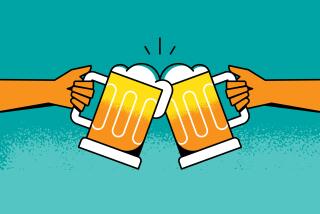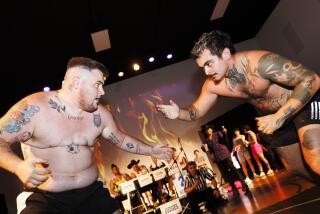Fighting to Overcome Violence : Boxers Offer Troubled Youth a Gym as an Alternative to the Street
- Share via
Louis Bernal steps forward and lightly cuffs 13-year-old Jose Esquivel with two quick right jabs. Esquivel responds with a flailing right hook which badly misses its intended target. Esquivel turns his back in frustration after two more of Bernal’s jabs glance off his forehead.
Frank Razo, who has been videotaping the practice session from ringside, takes the camera off his shoulder and beckons the youngster to his corner.
“Don’t turn your back,” Razo says. “Stick and move. Turn and face him.”
At 42, Bernal, thin and lithe, seems as fluid as he was years ago, when he fought as an amateur flyweight. He has always loved the fight game, although a soft voice and gentle demeanor away from the ring veil his passion.
It has been 20 years since Bernal donned boxing gloves for a bout, but the fighting in his life hasn’t abated.
Three years ago, his 20-year-old son, Louis Jr., was shot to death by four alleged gang members. Since then, Bernal has been has been engaged in an emotional battle for which there is no final bell.
Bernal does not spurn gang members. Instead, he embraces them. He says he understands the allure gangs have to some. And he offers an alternative.
For three hours each weekday afternoon, Bernal and Razo, another former amateur fighter, work as volunteer coaches at the North-East Police Station gym, helping youths aged 10-18 learn the fundamentals of boxing. On weekends, the two make house calls, taking the students on runs and conducting additional training sessions.
The gym, which was completed three months ago, bears little resemblance to the sweatshops portrayed in films such as “Rocky” and “Raging Bull.” The facilities are new, the patrons inexperienced. In fact, most of the boys have trained less than a month at the gym.
The ring was purchased two years ago with a $9,000 grant from the United States Olympic Committee, but went unused until gym construction began last September.
“I begged, borrowed and coaxed people to get involved,” said Doyle Baker, a police officer who built the gym with the help of Razo and North-East Explorers, youth volunteers aged 14-20.
Baker, appointed by police captain Noel Cunningham as coordinator of the program, said combatting the gang mentality is more difficult than many people believe.
“It’s hard for them to break old habits,” said Baker, whose program takes referrals on first-time offenders. “You can’t just jerk a kid off the street and say, ‘There--you’re clean.’ ”
The gym rules are strict. “There are no bandannas, no gang logos and no khakis,” Baker said, adding that youths cited for a second offense are banned from the program.
“We can’t put hardened criminals in with straight street kids,” he says. “We can’t mix bad blood with good.”
Attracting gang members for reform has been tough, Razo said, possibly because potential fighters are hesitant to approach the police station.
“I had one kid who was pretty good,” he said. “He was arrested and they brought him back here. He was here for about two weeks but I lost him back to his friends.
“With this particular kid I went out of my way and I spent some time with him. He was in some big trouble and he got expelled. So I told him I’d get him a job and try to get him back in school.”
Razo provided the youth with suitable clothes and arranged an interview, which eventually led to a position at a local department store. He also spoke to the vice principal of the boy’s school and tried, unsuccessfully, to get him re-enrolled.
“In here, he was showing a lot of discipline and he was picking it up fast,” Razo said. “He even brought in a couple of buddies.”
But then, for reasons unknown, he stopping coming.
Razo suggested that many of the youths who initially showed interest in the program might have lost enthusiasm when they discovered the discipline involved in training.
That discipline, however, appeals to Steve Amador, whose 12-year-old son, Sergio, began coming to the gym two weeks ago.
“I want him to go to Annapolis,” Amador said. “Education is the first thing, but there’s nothing wrong with being an educated athlete.”
Amador says his son can train at the gym without feeling pressured to step into the ring.
“They can come out, work out, go through the whole routine, but when it comes time to spar or box, it’s up to them,” he said. “They’re not forced or harassed.”
Bernal says the payoff is well worth the investment of time.
“If we could just help one--that’s a life,” he said. “We’re not only talking about grooming them for the future, for manhood, for the outside world, we’re talking about saving a life.”
More to Read
Go beyond the scoreboard
Get the latest on L.A.'s teams in the daily Sports Report newsletter.
You may occasionally receive promotional content from the Los Angeles Times.











